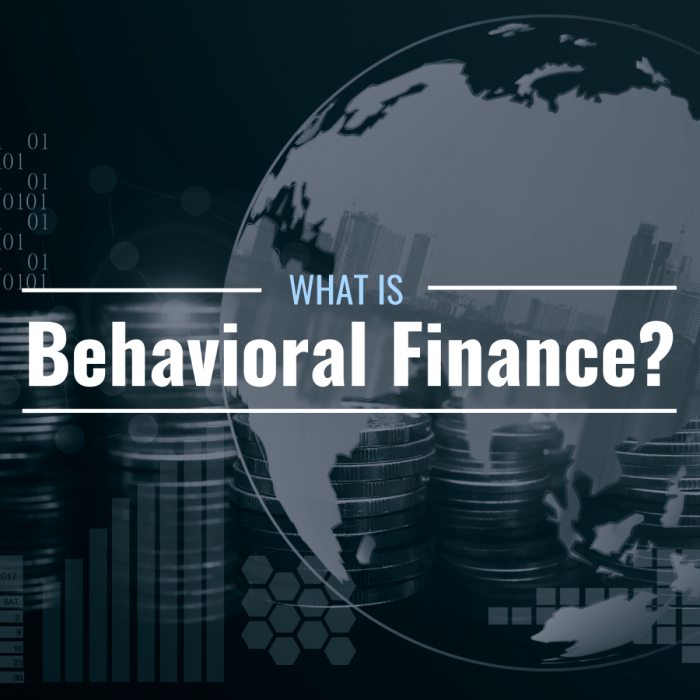As Behavioral finance insights take the spotlight, get ready to delve into a world where finance meets human behavior in a unique blend. This journey promises a mix of intriguing concepts and real-world applications that will leave you craving for more.
In the realm of finance, understanding the nuances of human behavior can unlock a whole new perspective on investment strategies and decision-making processes.
What is Behavioral Finance?
Behavioral finance is a branch of finance that explores how psychological factors influence the behavior of investors and the subsequent impact on financial markets. This field challenges the traditional assumption that investors are always rational and seeks to understand why and how they make decisions that deviate from standard economic theories.
Key Principles and Theories
- Loss Aversion: Investors tend to feel the pain of losses more strongly than the pleasure of gains, leading to risk-averse behavior.
- Overconfidence: Investors often overestimate their knowledge and abilities, leading to excessive trading and suboptimal decisions.
- Herding Behavior: Investors may follow the actions of the crowd without conducting independent analysis, leading to market bubbles and crashes.
- Mental Accounting: Investors segregate their money into different mental accounts and treat each account differently, affecting their investment choices.
Impact on Investment Decisions
- Market Anomalies: Behavioral finance has identified several anomalies in financial markets that cannot be explained by traditional theories, such as the momentum effect and the January effect.
- Investor Sentiment: Behavioral finance considers the impact of investor sentiment on market prices, showing how emotions can drive stock prices away from their intrinsic values.
- Investor Biases: By recognizing common biases like confirmation bias and anchoring, investors can better understand their decision-making processes and avoid costly mistakes.
Biases and Heuristics
Understanding biases and heuristics is crucial in the realm of behavioral finance as they play a significant role in shaping individual decision-making processes. Biases refer to systematic patterns of deviation from norm or rationality, while heuristics are mental shortcuts that individuals use to make judgments quickly.
Common Biases and Heuristics
Biases such as confirmation bias, where individuals seek out information that confirms their preexisting beliefs, and loss aversion, where people prefer avoiding losses over acquiring gains, are prevalent in behavioral finance. Heuristics like representativeness heuristic, where individuals make decisions based on how closely an event resembles a prototype, and availability heuristic, where people make decisions based on readily available information, also influence decision-making processes.
Comparison with Traditional Finance
In traditional finance, the assumption is that individuals make decisions rationally, considering all available information and maximizing their utility. However, in behavioral finance, biases and heuristics show that individuals often deviate from rationality due to psychological factors. This highlights the importance of understanding human behavior in financial decision-making.
Influence on Decision-Making
Biases and heuristics can lead individuals to make suboptimal decisions in financial matters. For example, overconfidence bias may cause individuals to take excessive risks, while framing bias can influence how choices are presented and perceived. By recognizing these biases and heuristics, individuals can become more aware of their impact on decision-making and strive to make more informed choices in the future.
Prospect Theory
Prospect theory is a behavioral finance concept that explains how people make decisions involving risk and uncertainty. Developed by Daniel Kahneman and Amos Tversky in 1979, this theory suggests that individuals do not always make rational choices when faced with uncertainty.
When it comes to real-world examples, prospect theory can be seen in situations where individuals exhibit loss aversion. This means that people tend to prefer avoiding losses rather than acquiring equivalent gains. For instance, investors may hold on to losing stocks longer than they should, hoping to avoid realizing the loss.
Application in Behavioral Finance
- One key aspect of prospect theory is the notion of framing effects, where the way information is presented can influence decision-making. For example, individuals may be more risk-seeking when a decision is framed in terms of potential gains rather than losses.
- Another important concept is the idea of reference points. People tend to evaluate outcomes based on a reference point, such as the price they paid for a stock. This can lead to irrational decision-making, as individuals may hold onto an investment simply because they do not want to sell it at a loss relative to the reference point.
Market Anomalies

Market anomalies are deviations from traditional financial theories that cannot be explained by rational behavior. These anomalies challenge the efficient market hypothesis and have important implications for asset pricing.
Momentum Effect
The momentum effect is a well-known market anomaly where stocks that have performed well in the past tend to continue performing well in the future, and vice versa. This contradicts the efficient market hypothesis, which assumes that stock prices reflect all available information instantaneously.
- Investors tend to underestimate the persistence of trends in stock prices, leading to mispricing.
- Market anomalies like the momentum effect suggest that markets are not always efficient in incorporating all available information.
Value Premium
The value premium anomaly refers to the tendency for value stocks (those with low prices relative to fundamentals) to outperform growth stocks (those with high prices relative to fundamentals) over the long term. This challenges the traditional view that higher risk should be rewarded with higher returns.
- Investors’ biases towards glamorous growth stocks often lead to undervaluation of more boring value stocks.
- The value premium anomaly suggests that market inefficiencies exist in the pricing of different types of stocks.
Post-Earnings Announcement Drift
The post-earnings announcement drift anomaly describes the tendency for stock prices to continue to drift in the direction of an earnings surprise even after the initial announcement. This phenomenon challenges the idea that stock prices fully adjust to new information quickly and efficiently.
- Investors may underreact to earnings surprises, leading to gradual price adjustments over time.
- The post-earnings announcement drift anomaly indicates that markets may not be as efficient as traditional theories assume.
